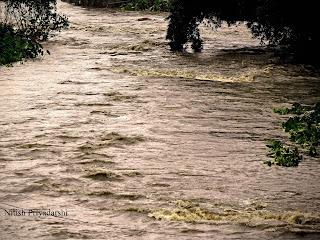Rivers flowing
through Ranchi
plateau may also contain thorium.
By
Dr. Nitish
Priyadarshi
Thorium deposits in India.
River flowing near Ranchi city.
Pegmatite intrusions in host rocks in Ranchi plateau.
Thorium is a naturally occurring radioactive chemical
element with the symbol Th and atomic number 90. It was
discovered in 1828 by the Norwegian mineralogist Morten Thrane Esmark and
identified by the Swedish chemist Jöns Jakob Berzelius and named after Thor,
the Norse god of thunder. Thorium produces a radioactive gas, radon-220, as one
of its decay products. Secondary decay products of thorium include radium and actinium.
In nature, virtually all thorium is found as thorium-232, which undergoes alpha
decay with a half-life of about 14.05 billion years.
Berzelius was quite unaware of the tremendous amount of
power that this element stores within it. Subsequent development in the field
of nuclear science and technology, however, revealed that thorium might well
prove to be equal to the god after whom it was named.
Thorium, which is transmutated U-233 in a breeder reactor,
can be used as a nuclear fuel. It is presumed that with the development of
breeder technology, thorium will come to play a vital role in providing
electric power to millions.
Thorium is widely distributed in the earth’s crust with an
average abundance of 8 ppm (parts per million) and is usually associated with
uranium or the rare earth-earth elements. The principal mode of occurrence is
in the form of veins in granites, synites, pegmatites and other acidic intrusions
containing thorium- bearing minerals, such as thorite, thorianite, uranothorite
and monazite. Detrital monazite occurs in quartz-pebble conglomerates, beach
placers, inland placer deposits and dunes.
The largest known reserves of the thorium are contained in
the beach and inland placer deposits of monazite, which are exploited for their
rare-earth and ThO2 contents. Placer deposits of monazite are found
in Australia, Egypt, India,
Liberia, Brazil, Malaysia
and the USA (Florida).
Among the inland placer deposits containing heavy mineral
there are two appreciable concentrations of monazite, which are located in the Ranchi plateau of Jharkhand and the Purulia planes of West Bengal. These
occurrences cover an area of about 608 sq. km. forming a thin cover of an
average depth of about 50 cm (which may be locally up to 2m.). These deposits
have been formed due to the weathering and erosion of Precambrian gneisses and
schists, intruded by pegmatites and porphyritic granites, which are enriched in
monazite and other associated heavy minerals.
The placer minerals are released from their matrix by
weathering. The comminuted materials are washed slowly down slope to the
nearest stream or to the seashore. Moving stream water sweeps away the lighter
matrix, and the heavier placer minerals sink to the bottom or are moved
downstream relatively shorter distances. The sands of the rivers like
Swarnrekha, Jumar, Potpoto, kanchi, etc. flowing through Ranchi plateau may contain thorium in
considerable amount.
Thorium present in the river streambed sediments are mostly
of terrestrial origin and their concentrations are related to the type of
parent rocks and to the genesis of the sediments. The river sediments generally
exhibit large variation in composition. This variation can be related to the
chemical and mineralogical evolution of these sediments along the river,
influence of tributaries, or different properties of drained soil. The mobility
of radionuclides in the aqueous system is an important factor influencing the
content of radionuclides in river sediments. Surface run-off waters in the
tributaries wash down a part of deposited radionuclides and finally store them
in the river sediments.
Most of the radioactive anomalies in the Damodar Valley
basins are confined to the Panchet
sandstones with the preponderance of thorium over uranium. A similar
pattern has also been observed in the Barakar sediments of the Hutar basin.
The granites of the provenance areas fir the
Hutar-Daltonganj basins contain anomalous uranium values. Uranium
mineralization has also been observed in the granitic rocks comprising the
southern periphery of the Hutar basin. The Proterozoic granitoids, forming the
provenance for the Hutar and Auranga sub basin (Jharkhand), have been analysed
which revealed uranium content up to 520 ppm, while the clays and sandstones of
Barakar Formations have revealed anomalous uranium-thorium values of the order
of 120-150 ppm uranium and less than 100-800 ppm thorium.
Reference:
Bateman, A.M. 1955. Economic mineral deposits. John Wiley
& Sons, Inc. New York.
Virnave, S.N. 1999. Nuclear geology and atomic mineral
resources. Bharti Bhawan, Patna.
Viswanathan, G., Badri, N.S.R., and Virnave, S.N. 1989.
Radioelement distribution in the Lower Gondwana
sediments of Hutar basin, Palamau district, Jharkhand; its bearing on uranium
exploration. Exploration Research Atomic minerals Vol. 2 , pp 121-131.
http://large.stanford.edu/courses/2012/ph241/bordia1/



















